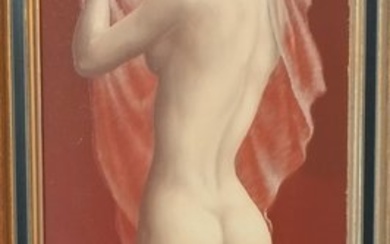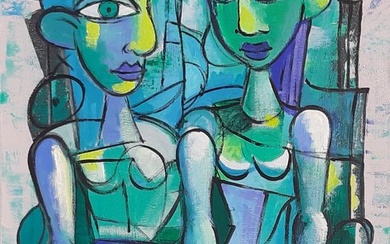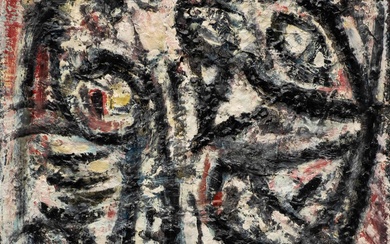UNTITLED
ANOTHER PROPERTY
Oil on canvas
1982
48 x 36 in. (121.9 x 91.4 cm.)
Signed and dated 'Tyeb / 82' and inscribed 'Tyeb M... / 4353' on Gallery Chemould label on reverse
PROVENANCE:
Originally purchased from Gallery Chemould, Mumbai in 1997.
Tyeb Mehta is not a prolific painter. He is not possessed by the frenzy of Van Gogh, nor the delirium tremens of the action painters; it has never been his ambition to out-Pollock Pollock. The restraint should not be mistaken for laziness nor lack of ideas, but rather his recognition of the discipline of art: the careful, almost ascetic tempering of the sensibility and the spirit, inwardly, through contemplation, thought, and concentration; allowing the original idea to be distilled through the sieve of time, so that what ultimately takes shape is the result of a profound, significant experience.' (Ebrahim Alkazi, quoted by Dilip Chitre, 'Celebrating Tyeb Mehta', published in Tyeb Mehta, Ideas Images Exchanges, New Delhi 2005, p. 325)
In 1947, Tyeb Mehta witnessed a man being stoned to death during the partition riots. The experience haunted the artist for the rest of his life, and provided the early catalyst that led him to search for a language that expressed this anguish. The early works of Mehta are marked by metaphoric imageries of maimed or mutilated bulls, or sad, lonely isolated figures, rendered in a thick impasto, a method inspired by the works of the Expressionists (see lot 27 for an example). By the late 1960s and early 1970s, the thick palette knife and layers of impasto gave way to a flatter canvas where large saturated areas of colour were used to depict his chosen subject.
In 1968, Mehta left India to go to New York on a Rockefeller Fellowship. On his arrival, his interaction with the American abstract painter Barnett Newman played a significant role in the stylistic shift seen in his work. He greatly admired the way Newman was able to break up the picture plane by using blocks of pure saturated colour. However, unlike Newman, Mehta did not wish to entirely abandon the figure from his work. Instead, he looked to combine the intensity of pure colour, with a figurative composition. The result was a departure from the perspective and tonal variations seen in his earlier expressionist works. The heavy impasto was abandoned in favour of large expanses of solid colour, and clean minimalist lines. The figures appear bare, free of any distraction. The swift lines denote motion, and the splintered planes of colour alone become suggestive of torment or dislocation. 'I became interested in using pure colour. Normally brush marks suggest areas of directions. I wanted to avoid all this to bring elements down to such a minimal level that the image alone would be sufficient to speak for itself.' (Tyeb Mehta in conversation with Nikki Ty-Tomkins Seth, op. cit, p. 342)
Each of Tyeb Mehta's paintings act as a silent movie, in which we see mouths screaming, faces distended in terror, flailing limbs, thrashing wings; but the artist leaves it to us to imagine the horror of sound. These complexities of achievement ensure that Tyeb's art is not simply figurative, but rather, is figural; it does not content itself merely with representing the human form, but navigates between abstraction and conceptual play on the one hand, and the illusionism of representation on the other.' (Ranjit Hoskote, 'Images of Transcendence, Towards a New Reading of Tyeb Mehta's Art', op. cit, p. 20)
In the current artwork, Mehta places the protagonist against a bold yellow backdrop above a foreground of deepest burgundy that appears to protrude outwards, suggestive of a three-dimensional space. Further planes of colours overlap each other, converging together somewhere behind the main figure. Following on from the Diagonal series of the previous decade, this painting retains a sense of the diagonal divide from top right to lower left, without actually defining a diagonal cut of colour across the painting. The work also retains compositional elements from two of his earlier paintings,Yellow Heads and Sequence, both completed the previous year. In Yellow Heads the diagonal is more defined, whilst in Sequence the seated figure whose posture reflects the current figure, is part of a larger drama. Likewise, the raised right hand, is reminiscent of the gesticulations of figures from the Gesture Series of the late 1970s. It is in this sense that Alkazi talks about Tyeb's ideas being 'distilled' through contemplation. Here, the artist, at the apex of his career, blends several key elements, having by this late stage in his career, successfully created a distinctive visual style that perfectly balances figuration and abstraction.
'The solitary human figure, whether seated, standing or falling, is omnipresent. The human figure has become part of my vocabulary, like a certain way of applying colour or breaking up images. It is a sort of vehicle for me. I am not a minimalist or abstract painter... my work is still expressionist. The human figure is my source, what I primarily react to. But in transferring that image to canvas, I begin to think in terms of modulating the canvas, distributing areas of color and apportioning space. I put a certain distance between myself as the seer and the canvas as the seen, to allow the painting to exist as an entity in its own right.' (Tyeb Mehta in conversation with Nikki Ty-Tomkins Seth, op. cit, p. 343)
# Import duty at 10.3% will be charged on the hammer price and GST will be applicable on the total amount of the hammer price plus the import duty.
View it on
Estimate
Time, Location
Auction House
ANOTHER PROPERTY
Oil on canvas
1982
48 x 36 in. (121.9 x 91.4 cm.)
Signed and dated 'Tyeb / 82' and inscribed 'Tyeb M... / 4353' on Gallery Chemould label on reverse
PROVENANCE:
Originally purchased from Gallery Chemould, Mumbai in 1997.
Tyeb Mehta is not a prolific painter. He is not possessed by the frenzy of Van Gogh, nor the delirium tremens of the action painters; it has never been his ambition to out-Pollock Pollock. The restraint should not be mistaken for laziness nor lack of ideas, but rather his recognition of the discipline of art: the careful, almost ascetic tempering of the sensibility and the spirit, inwardly, through contemplation, thought, and concentration; allowing the original idea to be distilled through the sieve of time, so that what ultimately takes shape is the result of a profound, significant experience.' (Ebrahim Alkazi, quoted by Dilip Chitre, 'Celebrating Tyeb Mehta', published in Tyeb Mehta, Ideas Images Exchanges, New Delhi 2005, p. 325)
In 1947, Tyeb Mehta witnessed a man being stoned to death during the partition riots. The experience haunted the artist for the rest of his life, and provided the early catalyst that led him to search for a language that expressed this anguish. The early works of Mehta are marked by metaphoric imageries of maimed or mutilated bulls, or sad, lonely isolated figures, rendered in a thick impasto, a method inspired by the works of the Expressionists (see lot 27 for an example). By the late 1960s and early 1970s, the thick palette knife and layers of impasto gave way to a flatter canvas where large saturated areas of colour were used to depict his chosen subject.
In 1968, Mehta left India to go to New York on a Rockefeller Fellowship. On his arrival, his interaction with the American abstract painter Barnett Newman played a significant role in the stylistic shift seen in his work. He greatly admired the way Newman was able to break up the picture plane by using blocks of pure saturated colour. However, unlike Newman, Mehta did not wish to entirely abandon the figure from his work. Instead, he looked to combine the intensity of pure colour, with a figurative composition. The result was a departure from the perspective and tonal variations seen in his earlier expressionist works. The heavy impasto was abandoned in favour of large expanses of solid colour, and clean minimalist lines. The figures appear bare, free of any distraction. The swift lines denote motion, and the splintered planes of colour alone become suggestive of torment or dislocation. 'I became interested in using pure colour. Normally brush marks suggest areas of directions. I wanted to avoid all this to bring elements down to such a minimal level that the image alone would be sufficient to speak for itself.' (Tyeb Mehta in conversation with Nikki Ty-Tomkins Seth, op. cit, p. 342)
Each of Tyeb Mehta's paintings act as a silent movie, in which we see mouths screaming, faces distended in terror, flailing limbs, thrashing wings; but the artist leaves it to us to imagine the horror of sound. These complexities of achievement ensure that Tyeb's art is not simply figurative, but rather, is figural; it does not content itself merely with representing the human form, but navigates between abstraction and conceptual play on the one hand, and the illusionism of representation on the other.' (Ranjit Hoskote, 'Images of Transcendence, Towards a New Reading of Tyeb Mehta's Art', op. cit, p. 20)
In the current artwork, Mehta places the protagonist against a bold yellow backdrop above a foreground of deepest burgundy that appears to protrude outwards, suggestive of a three-dimensional space. Further planes of colours overlap each other, converging together somewhere behind the main figure. Following on from the Diagonal series of the previous decade, this painting retains a sense of the diagonal divide from top right to lower left, without actually defining a diagonal cut of colour across the painting. The work also retains compositional elements from two of his earlier paintings,Yellow Heads and Sequence, both completed the previous year. In Yellow Heads the diagonal is more defined, whilst in Sequence the seated figure whose posture reflects the current figure, is part of a larger drama. Likewise, the raised right hand, is reminiscent of the gesticulations of figures from the Gesture Series of the late 1970s. It is in this sense that Alkazi talks about Tyeb's ideas being 'distilled' through contemplation. Here, the artist, at the apex of his career, blends several key elements, having by this late stage in his career, successfully created a distinctive visual style that perfectly balances figuration and abstraction.
'The solitary human figure, whether seated, standing or falling, is omnipresent. The human figure has become part of my vocabulary, like a certain way of applying colour or breaking up images. It is a sort of vehicle for me. I am not a minimalist or abstract painter... my work is still expressionist. The human figure is my source, what I primarily react to. But in transferring that image to canvas, I begin to think in terms of modulating the canvas, distributing areas of color and apportioning space. I put a certain distance between myself as the seer and the canvas as the seen, to allow the painting to exist as an entity in its own right.' (Tyeb Mehta in conversation with Nikki Ty-Tomkins Seth, op. cit, p. 343)
# Import duty at 10.3% will be charged on the hammer price and GST will be applicable on the total amount of the hammer price plus the import duty.







